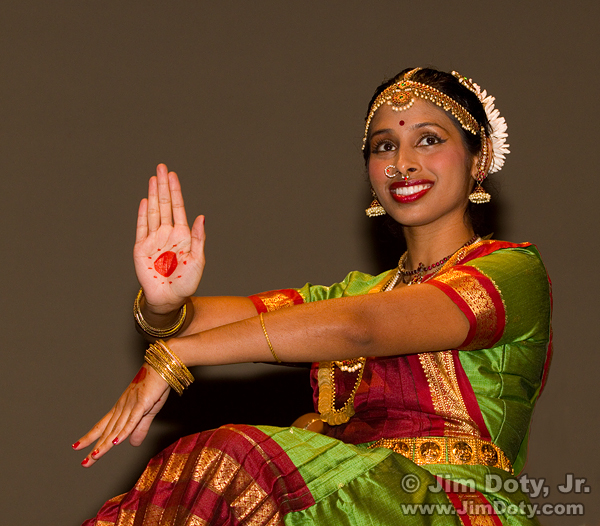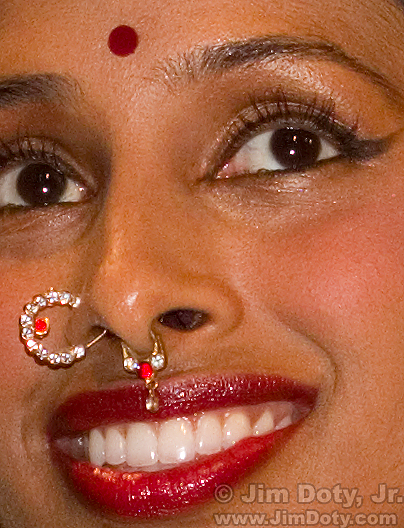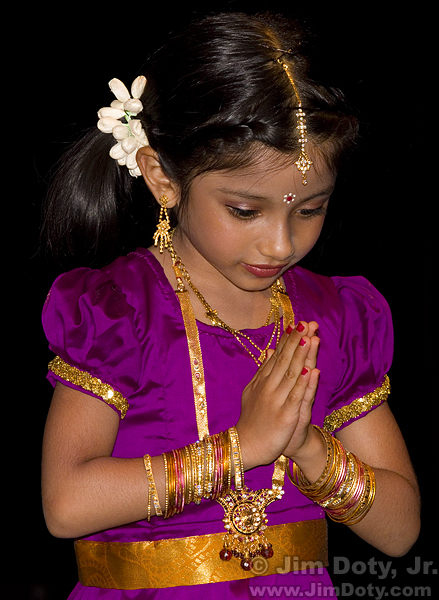Shooting “events” is both challenging and rewarding. The photographer has very little control over the lighting and the position of the subjects (unlike most other kinds of photography), so you make the most of what happens and improvise. Shooting events will do wonders for your photographic skills, not to mention the eye-catching photos that can be captured.
Recently I was the official photographer for a “Dance Drama” on the life and teachings of Sri Shirdi Saibaba. With over 200 performers and story tellers, it was a visual feast for a photographer. It was also a fascinating and informative look at the life of Baba.
My cameras were set to RAW + jpeg capture, the RAW images (processed with Adobe Camera Raw) gave me maximum image quality. The jpegs are handy when I need a quick image to email.
Light levels were low much of the time (at least in terms of photography), the dancers moved quickly, and flash was permitted, so I used electronic flash for many of the photos.
When I went with the ambient stage lights (no flash), I set the camera’s white balance to tungsten, jumped the ISO to 1000 or 1250, opened the aperture to around f/4 (not much depth of field). The shutter speed was around 1/20 second, not fast enough to freeze the action in a dance. You have to catch a pause in the action.
For flash photography, I set the white balance to flash, which affected the jpegs and the LCD image on the back of the camera, but not the RAW files. I set the ISO to 400. Light falls off with the square of the distance, so you need an ISO like 400 or 800 for your flash to have enough reach when your subjects are 40, 50, and 60 feet away. I was also using powerful flash units, one on each camera. A pop up flash just won’t cut it, even at high ISO speeds.
My lens aperture was set to f/8 for the photo above. I used f/11 when I wanted a little more depth of field. The shutter speed was set to 1/60 or 1/80 for most flash photos.  I also set the flash exposure compensation to minus 1/3 to minimize the chances of blown out highlights. For more information on flash photography (and photography in general), check out my new photography book.
Things happen too quickly at a dance to change lenses. To avoid missed photos, I used two camera bodies and two lenses for most of my shooting. I had a 24-105mm lens on my Canon 5D for wide angle, normal, and short telephoto focal lengths. To get close to the dancers optically, I used a Canon EF 70-200mm f/4 IS lens on a Canon 7D, giving me an equivalent focal length (in 35mm terms) of 112-320mm. That gave me plenty of reach. Between the two lenses, I was good to go from 24-320 mm (with an unimportant gap from 105-112 mm). If I needed more width, I also had a 17-40mm lens and 15mm fisheye lens with me
The 7D/70-200mm lens combination does very well in terms of autofocus, so I used autofocus most of the time. The 70-200mm lens is super sharp. The photo below is a 100%, “actual pixels” crop from the photo at the top of this post. Keep in mind that this dancer was moving when the photo was taken (I did try to pick a moment when she wasn’t moving too quickly), so the camera/lens autofocus did very well and the lens quality gave me a very nice image. Look at the detail around the eyes.
The processed RAW file for this image could easily hold up in quality in a size up to a 20 x 24 inch enlargement.
The only major post processing to the image was to remove an out of focus dancer in the background.
Here is one more photo from the Dance Drama. The same 7D/70-200mm lens combination was used.



